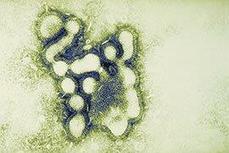Baloxavir: A New, Single-Dose Antiviral
A 64-year-old otherwise healthy virology professor comes to your office complaining of flu symptoms. She has had fever, cough, and sore throat for the last day or so that she attributes to one of her students. She has been furiously sanitizing her hands and comes to the office wearing a face mask. Being the savvy patient, she brings reverse transcriptase–polymerase chain reaction (RT-PCR) results that confirm she has influenza A virus (as does the student). She is febrile but hemodynamically stable with no signs of lower respiratory tract infection. She asks about available treatment options, explaining that she will be presenting at a conference tomorrow. How would you proceed? In this week’s NEJM, Hayden and colleagues report the results of two double-blind, randomized-controlled trials comparing single-dose baloxavir versus placebo or oseltamivir in patients with uncomplicated influenza in Japan and the United States during the 2015–2017 flu seasons. Baloxavir marboxil (Xofluza) is an important new addition to the armamentarium against flu because it represents a new class of antiviral drugs that target a different process than the other two classes available (amadantanes and neuraminidase inhibitors), and has antiviral activity against strains resistant to those agents. Baloxavir also has the advantage of requiring a single dose, as compared to 5 days of twice daily oseltamivir (Tamiflu). Baloxavir is a cap-dependent endonuclease inhibitor that blocks viral replication by blocking the initiation of mRNA synthesis (read more here). In the phase 3 trial (CAPSTONE-1), the investigators randomized 1436 patients (age range, 12–64 years) with uncomplicated flu to receive a single dose of baloxavir (40 mg), oseltamivir (75 mg twice daily for 5 days), or matching placebos (with those aged 12-19 assigned only to baloxavir or placebo). Uncomplicated flu was defined as fever ≥38.0°C, at least one systemic symptom and one respiratory symptom, and presentation with 48 hours of symptom onset. Pregnant women and those requiring hospitalization were excluded. The primary endpoint was the time until flu symptoms became absent or mild for at least 21.5 hours. The intention-to-treat infected population included only RT-PCR-positive patients. Roughly 85% of patients in the three treatment groups were infected with influenza A (H3N2) and most (77%) were recruited in Japan. The time to alleviation of symptoms was significantly shorter (by 26.5 hours) in the baloxavir group, when compared with the placebo group (median, 53.7 vs. 80.2 hours), and similar to the oseltamivir group (53.5 vs. 53.8 hours). Baloxavir was associated with significantly more rapid decline in potentially infectious viral load as compared to both oseltamivir and placebo. The rate of adverse events was similar in the three groups. Emergence of mutations conferring reduced baloxavir susceptibility occurred in fewer than 10% of baloxavir recipients, which prolonged time to resolution of symptoms by about 13 hours. Per CDC recommendations, only individuals with acute influenza who are at high risk of related complications (e.g., in a chronic care facility, pregnant, age ≥65 years) should receive antiviral treatment. Hence, the results of this trial are not likely to affect current practice or treatment of the professor described above. The importance of this study lies in the demonstration of the safety and efficacy of baloxavir for treatment of uncomplicated acute influenza in otherwise healthy patients. These encouraging results will form the basis for future study of baloxavir in higher risk populations, where its utility and future clinical indications may lie. Browse more From Pages to Practice » Tenzing T. Lama, MD, MScRes, is a resident physician in the Department of Anesthesiology and Pain Medicine at the University of Washington and a Fellow at the Ethics and Transformative Values Center at the Massachusetts Institute of Technology. He graduated from Harvard Medical School and Oxford.
Baloxavir: A New, Single-Dose Antiviral
Source: Virology News
